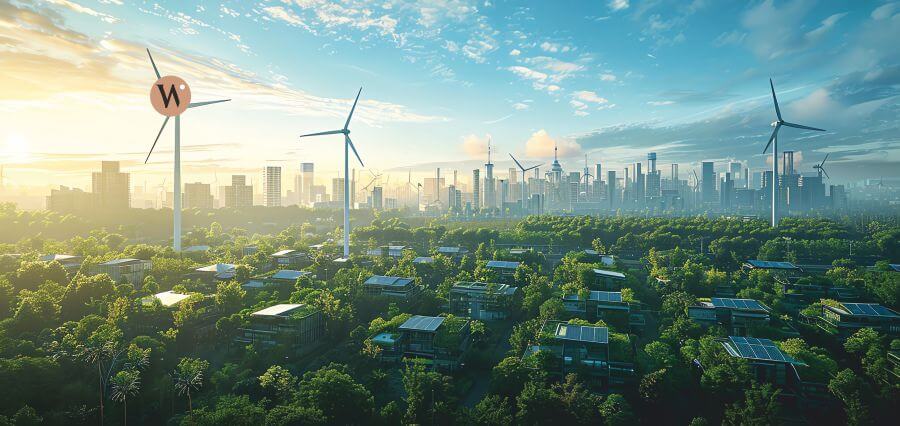Increasing global concerns about climate change coupled with an urgent need for a clean source of energy calls for alternative sources. Among the much-needed sources of sustainable energy solutions, green hydrogen has gained prominence as the world seeks to drastically cut carbon emissions. Unlike traditional hydrogen, green hydrogen is produced from electrolysis fueled by renewable energy sources, hence completely carbon-free. The potential to alter everything from transportation to manufacturing in a fully scalable, clean energy solution can change everything.
Let’s find out how green hydrogen is going to shape the future of sustainable energy, as we understand its potential benefits and challenges ahead!
What is Green Hydrogen?
Green hydrogen is produced by splitting water molecules into hydrogen and oxygen by the use of renewable energy such as wind or solar power. This method of electrolysis is not entirely a new thing; however, the momentum is increasing presently due to the decrease in the cost of renewable sources with time. Green hydrogen is intended to be emission-free when produced. It’s one of the cleanest energy carriers available since the only byproduct of its burning or conversion to electricity through fuel cells is water vapor.
What makes hydrogen green is not only its production process but also how versatile it is. It is easy to store and transport, thus potentially making it a huge facilitator of decarbonizing entire industries such as heavy industry, aviation, and shipping, which are difficult so far to transition to cleaner alternatives.
Green Hydrogen vs Other Energy Sources
The unique advantage of green hydrogen, as compared to other sources like solar, wind, or battery storage, is that it can be stored for a long period. Unlike solar and wind, though both are efficient, their energy supply is intermittent: they produce electricity only when the sun shines and the wind blows. A battery, on the other hand, is practical for medium-term storage but not really for long-term use.
Green hydrogen can be produced when renewable energy is plentiful and stored for when demand is high or when supplies are low. This makes it a very good complement to other sources of renewable energy. And whilst batteries lose much of their energy content with age, hydrogen can be stored for millennia with no decay in its energy. Perhaps this long-term storage will help even out the peaks and troughs in renewable energy production, creating a more stable and robust energy grid.
Industries Benefiting from Green Hydrogen
Many sectors stand a great chance of benefiting from the deployment of green hydrogen. However, the very first significant sector that is going to benefit directly from green hydrogen is transportation. The very first area will be passenger vehicles, while heavy-duty trucking also looks promising in terms of using hydrogen-powered fuel cells. While battery electric vehicles take hours to fully charge, for hydrogen fuels, it’s possible to fill up in a matter of minutes, making it a pretty practical solution for longer distances.
But heavy steel and cement industries, for example, have a huge potential. These are significant emitters of carbon, but green hydrogen could be easily substituted for fossil fuels in much industrial production. Hydrogen also can be used to generate electricity via combustion or in fuel cells, as a cleaner alternative to natural gas.
Barriers to Widescale Deployment
Although green hydrogen offers many advantages, several challenges have to be met for this fuel to be intensified in energy supplies. Some of the major inhibitions include cost; despite the decrease in the production cost of green hydrogen recently, it is still expensive compared to the one produced through fossil fuels. This is attributed to both the price of renewable energy in some regions as well as the inefficiencies attributed to the current electrolysis technology.
One other prominent challenge lies in the infrastructure: mass production of green hydrogen would require gigantic investments in production facilities, transportation networks, and refueling stations. These rollouts of infrastructural developments need to be organized along the regions and industries involved in making hydrogen to produce, store, and transport in scale.
The Future of Green Hydrogen
For green hydrogen to be taken to its full potential, concerted efforts are needed from governments, industries, and investors. Governments can help by introducing subsidies, tax incentives, and mechanisms for carbon pricing to promote the use of green hydrogen against traditional fossil fuels. Industries should accelerate the transition by investing in research and development that increases efficiency and lowers the costs of technologies used in hydrogen production.
With economies of scale applied in scaling up the production of green hydrogen, the costs would erode with every increase in the more there is, the more there will be application areas. Infrastructure development and building up to support the consumption of hydrogen-based energy systems shall be a concerted effort from many sectors including energy, transportation, and manufacturing.
In conclusion,
The future of energy takes on shape by using green hydrogen as a clean, versatile, and storable energy carrier for a world full of promises. Even though there are big challenges, especially cost and infrastructure, growing momentum allows green hydrogen to move forward. If the industries, governments, and innovators work out each other’s solutions, green hydrogen will be one of the cornerstones supporting the worldwide energy transition towards a cleaner, more sustainable future for coming generations.





Your point of view caught my eye and was very interesting. Thanks. I have a question for you.